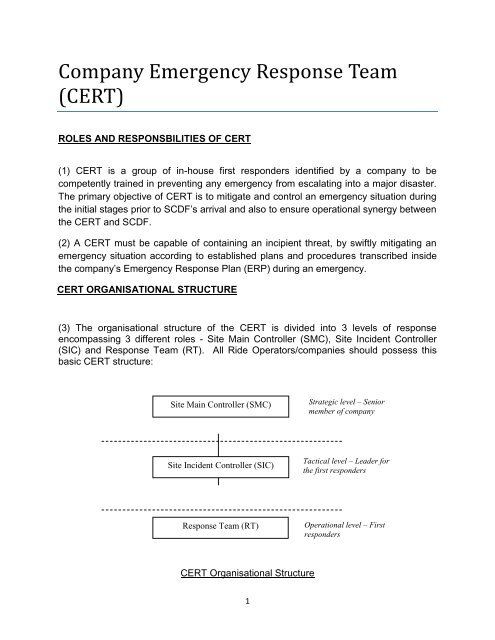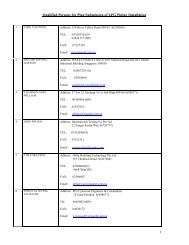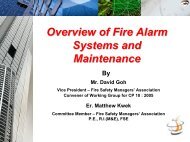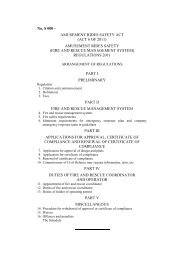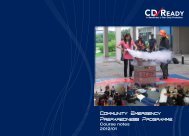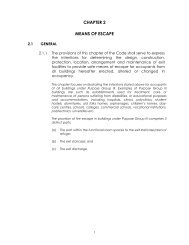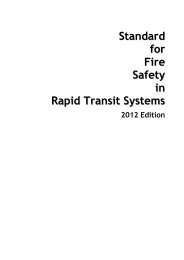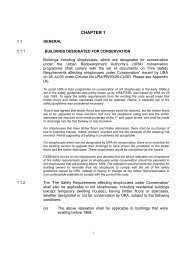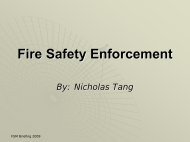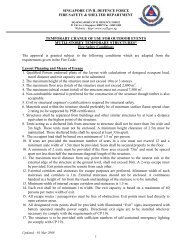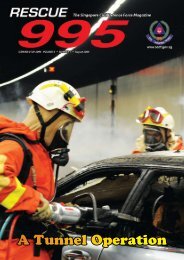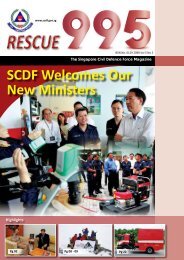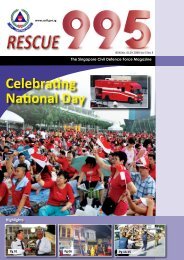Company Emergency Response Team (CERT)
Company Emergency Response Team (CERT)
Company Emergency Response Team (CERT)
You also want an ePaper? Increase the reach of your titles
YUMPU automatically turns print PDFs into web optimized ePapers that Google loves.
<strong>Company</strong> <strong>Emergency</strong> <strong>Response</strong> <strong>Team</strong><br />
(<strong>CERT</strong>)<br />
ROLES AND RESPONSBILITIES OF <strong>CERT</strong><br />
(1) <strong>CERT</strong> is a group of in-house first responders identified by a company to be<br />
competently trained in preventing any emergency from escalating into a major disaster.<br />
The primary objective of <strong>CERT</strong> is to mitigate and control an emergency situation during<br />
the initial stages prior to SCDF’s arrival and also to ensure operational synergy between<br />
the <strong>CERT</strong> and SCDF.<br />
(2) A <strong>CERT</strong> must be capable of containing an incipient threat, by swiftly mitigating an<br />
emergency situation according to established plans and procedures transcribed inside<br />
the company’s <strong>Emergency</strong> <strong>Response</strong> Plan (ERP) during an emergency.<br />
<strong>CERT</strong> ORGANISATIONAL STRUCTURE<br />
(3) The organisational structure of the <strong>CERT</strong> is divided into 3 levels of response<br />
encompassing 3 different roles - Site Main Controller (SMC), Site Incident Controller<br />
(SIC) and <strong>Response</strong> <strong>Team</strong> (RT). All Ride Operators/companies should possess this<br />
basic <strong>CERT</strong> structure:<br />
Site Main Controller (SMC)<br />
Site Incident Controller (SIC)<br />
<strong>Response</strong> <strong>Team</strong> (RT)<br />
<strong>CERT</strong> Organisational Structure<br />
1<br />
Strategic level – Senior<br />
member of company<br />
Tactical level – Leader for<br />
the first responders<br />
Operational level – First<br />
responders
(4) The SMC is a senior member of the Ride Operator/company’s management. He is<br />
the overall person-in-charge of emergency response operations in the company and<br />
deals with senior government officials from SCDF, Singapore Police Force (SPF), etc.<br />
The SIC is the leader of the <strong>CERT</strong>, in charge of the incident response. The RT consists<br />
of personnel trained in basic emergency response actions such as fire fighting, rescue<br />
mitigation and other supporting activities such as security, evacuation, first aid etc.<br />
<strong>CERT</strong><br />
COMPONENTS<br />
Site Main<br />
Controller (SMC)<br />
Site Incident<br />
Controller (SIC)<br />
<strong>Response</strong> <strong>Team</strong><br />
(RT)<br />
MANPOWER REQUIREMENTS<br />
ROLES AND RESPONSIBILITIES<br />
Assumes the overall authority and responsibility in<br />
managing the emergency situation and liaising<br />
with officers from government agencies such as<br />
SCDF, SPF, NEA, etc. He/She will be the<br />
representative to link up with the Incident Manager<br />
(SCDF) to assist in the incident management.<br />
Assumes command and control of the emergency<br />
response incident scene and co-ordinates the<br />
activities of all emergency responders, providing<br />
support to SCDF for mitigation of the emergency<br />
situation.<br />
Conducts basic emergency response actions such<br />
as fire fighting, rescue and HazMat mitigation<br />
under the command of the SIC.<br />
Assists in emergency notification and public<br />
protective actions, accounting for personnel<br />
outside the hazard zone or implementing In-Place<br />
Protection (IPP) within the workplace.<br />
(5) All Ride Operators/companies that require <strong>CERT</strong> should maintain a minimum <strong>CERT</strong><br />
configuration of at least 6 members (comprising 1 SMC, 1 SIC and 4 RT members) or<br />
more to sufficiently handle the worst credible scenario effectively. The final <strong>CERT</strong><br />
configuration set up by the company shall be subjected to SCDF’s approval through the<br />
<strong>CERT</strong> audit.<br />
(6) The <strong>CERT</strong> could comprise security guards, safety staff, technical staff, operations<br />
staff as well as any other employees within the premise. The team should be familiar<br />
with the Ride’s ERP. They should be adequately trained to provide initial response to<br />
the scenarios described in the ERP.<br />
2
TRAINING REQUIREMENTS<br />
(7) Training has an important bearing on the safety and proficiency of the <strong>CERT</strong> and can<br />
make a significant difference in the <strong>CERT</strong>’s response during the initial stages of an<br />
incident. The Ride Operator should provide adequate emergency response training to<br />
all their staff. SIC and first responders should be trained in fire-fighting and rescue<br />
operation.<br />
(8) The training provided may be customised to suit the Ride Operator’s operating<br />
environment. A general guideline on the training requirements to meet the various roles<br />
are as below.<br />
Training<br />
Requirements<br />
Fire Fighting &<br />
Rescue<br />
<strong>Response</strong><br />
Incident<br />
Management<br />
Types of Training <strong>CERT</strong> Members<br />
Fire protection systems in<br />
buildings/process plants<br />
Use of breathing apparatus<br />
First attack fire fighting using various<br />
extinguishing media (e.g.<br />
extinguishers, hose reels, hoses and<br />
nozzles)<br />
First aid and CPR<br />
Evacuation<br />
Safety precautions<br />
Appreciation of situation<br />
Strategic and tactical operations<br />
Roles and responsibilities<br />
<strong>Response</strong> planning<br />
Contingency planning<br />
<strong>Emergency</strong> scene management<br />
Overview of SCDF incident<br />
management system<br />
<strong>Emergency</strong> information management<br />
Table-top planning exercises<br />
(9) To ensure that the <strong>CERT</strong> remains relevant and current, each Ride Operator is<br />
recommended to conduct in-house refresher courses. Alternatively, the Ride Operators<br />
can engage external trainers to conduct in-house training or send their <strong>CERT</strong> to training<br />
institutions for refresher courses.<br />
3<br />
<strong>Response</strong> <strong>Team</strong><br />
Site Incident<br />
Controller<br />
Site Main<br />
Controller<br />
Site Incident<br />
Controller
EQUIPMENT READINESS AND MAINTENANCE<br />
(10) The equipment used by the <strong>CERT</strong> should be able to handle the initiating event of<br />
the worst credible scenario described in the ERP and the types of hazards present<br />
within the premises. Although a Ride Operator can consider requesting for assistance<br />
in the form of mutual aid agreement with their neighbouring premises, it is still required<br />
to maintain sufficient equipment to handle the initial phases of an emergency.<br />
Equipment should be regularly maintained and stored in accessible locations. Some<br />
equipment required is:<br />
a. Personal Protective Equipment (PPE)<br />
The Ride Operators should equip their <strong>CERT</strong> members with the<br />
appropriate PPE. All PPE should be kept in accessible locations for easy<br />
retrieval during an emergency. Regular maintenance of the equipment is<br />
important to ensure that it is in good working condition at all times. <strong>CERT</strong><br />
should be sufficiently trained to don their PPE competently.<br />
b. <strong>Emergency</strong> <strong>Response</strong> Equipment<br />
<strong>Emergency</strong> response equipment refers to detection and mitigation<br />
equipment. The equipment should be properly maintained to ensure<br />
optimal performance during emergencies. <strong>CERT</strong> should be regularly<br />
trained to be proficient in the usage of the equipment.<br />
c. Communication Equipment<br />
To ensure proper communication, the company should provide <strong>CERT</strong><br />
members with radio communication sets and/or loudhailer or any other<br />
equivalent form of communication tools.<br />
EMERGENCY PLANS AND STAFF AIDS<br />
<strong>Emergency</strong> Plans<br />
(11) It is crucial for the Ride Operators to identify and quantify hazards and risks related<br />
to the rides. This is through developing an ERP to detail the various preventive<br />
measures and operational actions that need to be undertaken by the company to<br />
mitigate the worst credible scenario.<br />
(12) The Ride Operators should place great emphasis on preparing the written<br />
emergency plans, keeping them up-to-date and ensuring that they have been briefed to<br />
all employees. They should be placed in an accessible location for workers to view and<br />
retrieve during an emergency.<br />
4
Staff Aids<br />
(13) Besides the Ride’s ERP, other important supporting documents such as maps and<br />
diagrams and technical specifications of the rides will assist the SCDF Ground<br />
Commander to better appreciate the surrounding hazards. These documents, also<br />
known as emergency staff aids, should be regularly updated and available at all times:<br />
a. Site/ Plant layout diagrams;<br />
b. Layout plans and inventory list of hazardous substances if any;<br />
c. <strong>CERT</strong> activation flowchart;<br />
d. <strong>Emergency</strong> contact list;<br />
e. Materials Safety Data Sheets (MSDS);<br />
f. <strong>Emergency</strong> control points (e.g. <strong>CERT</strong> assembly point, evacuee assembly<br />
point, first aid point);<br />
g. Government agencies contact numbers (e.g. SCDF, SPF); and<br />
h. Recovery contractor contact number.<br />
Certification Requirement<br />
(1) In order to ascertain the competency level of the <strong>CERT</strong> in carrying out its tasks in an<br />
emergency, SCDF shall conduct audits through documental checks and practical<br />
assessments on the companies. The onsite audits of the <strong>CERT</strong>s will serve as an<br />
opportunity to identify strengths and weaknesses of their capability. During the audits,<br />
the <strong>CERT</strong>s have to successfully demonstrate their response capability through a list of<br />
specific activities such as incident size-up and fire fighting operations. Each of the<br />
activities consists of individual and specific tasks that have to be carried out as<br />
stipulated in the <strong>CERT</strong> Audit Checklist.<br />
<strong>CERT</strong> AUDIT WORK PROCESS<br />
Scheduling of Companies for <strong>CERT</strong> Audits<br />
(2) Ride Operators applying for the ARSA licence will need to submit their ERP to SCDF<br />
for verification and scheduled for mandatory <strong>CERT</strong> audits.<br />
5
(3) Notification letters will be sent to the Ride Operators to inform them of the date and<br />
time of their audits 1 month in advance of the audit dates that will be mutually agreed by<br />
the Ride Operators.<br />
Confirmation of Audit Scenario<br />
(4) The audit team will visit the company one week before the scheduled practical audit<br />
date to go through the documents for the documentation aspect of the audit and to<br />
discuss with the company’s SMC or SIC, the scenario to be exercised during the<br />
practical audit. The scenario should be based on the worst credible scenario depicted<br />
in the company’s ERP.<br />
Conduct of <strong>CERT</strong> Audit<br />
(5) The audit team will conduct the <strong>CERT</strong> practical audit on the scheduled date. The<br />
<strong>CERT</strong> audit will be conducted in 2 phases: the interview phase; and exercise phase:<br />
a. Interviews are first conducted for the <strong>CERT</strong> members to test the<br />
understanding on their functions. These include the followings:<br />
i) Their understanding of their individual role and functions;<br />
ii) Their expected actions in the exercised scenario;<br />
iii) The activation phase of the scenario is evaluated by interviewing<br />
any company personnel on their knowledge of raising the alarm<br />
during an emergency; and<br />
iv) The <strong>CERT</strong> is also checked if they meet the minimum manpower<br />
requirement and organization structure.<br />
b. For scenario exercise, the <strong>CERT</strong> will be evaluated on the following activities:<br />
i) Activation and response of <strong>CERT</strong>;<br />
ii) Incident size-up;<br />
iii) Fire fighting and mitigation operations;<br />
iv) Support activities such as evacuation, medical treatment and<br />
security;<br />
v) Linking up with SCDF upon arrival; and<br />
vi) Ongoing operations and recovery.<br />
6
(6) At the end of the onsite assessment, the Audit <strong>Team</strong> will conduct a debrief session<br />
with the Ride Operators (includes at least the SMC or SIC) on the result and<br />
performance of the onsite <strong>CERT</strong> assessment. Any areas of improvement and<br />
recommendations will be highlighted to help the <strong>CERT</strong> improve their future responses.<br />
Follow Up Actions<br />
(7) Within 2 weeks from the successful completion of the <strong>CERT</strong> audit, the Audit team<br />
shall send the post-audit reports, highlighting on the strengths, weaknesses and<br />
recommendations for the <strong>CERT</strong>.<br />
Enforcement Actions<br />
(8) For all Ride Operators, new 1 or repeated 2 Ride Operators, which fail the audit,<br />
SCDF will issue a written direction to the company for the Ride Operators to improve on<br />
its <strong>CERT</strong> response. Another date will be scheduled by SCDF for the conduct of re-audit<br />
within 2 weeks. The scenario of the re-audit will be based on the same scenario as the<br />
first audit. The company shall be notified of the date of the re-audit via the notification<br />
letter.<br />
(9) The Ride Operators must pass the Audit Certification Test before they can be<br />
allowed to operate the Amusement Rides.<br />
COMPETENCY IN PRACTICAL ASSESSMENT<br />
(10) Practical assessment exercises, conducted collaboratively by SCDF and the Ride<br />
Operators, are key instruments for assessing and improving performance. A fire or<br />
rescue scenario is proposed by SCDF based on the worst credible scenario laid out in<br />
the company’s ERP. The desired outcome of the exercise is to certify that the<br />
company’s <strong>CERT</strong> is capable of containing an incipient threat, by swiftly mitigating an<br />
emergency situation according to established plans and procedures. During a practical<br />
exercise, the <strong>CERT</strong> should successfully demonstrate these capabilities through specific<br />
activities which include:<br />
a. Activation and <strong>Response</strong> of <strong>CERT</strong>;<br />
b. Incident Size-Up;<br />
c. Fire Fighting/Rescue and Mitigating operations;<br />
d. Support Activities;<br />
1 A new Ride Operator refers to a Ride Operator which is going through the audit for the first time<br />
2 A repeated Ride Operator refers to a Ride Operator which has gone through the <strong>CERT</strong> audit before<br />
7
e. Linking up with SCDF upon arrival; and<br />
f. Ongoing operations and recovery.<br />
(11) Every <strong>CERT</strong> should follow the guidelines as a demonstration of their capability to<br />
handle an emergency situation.<br />
a. Activation and <strong>Response</strong> of <strong>CERT</strong><br />
The first person who discovers the fire incident should activate the nearest fire<br />
alarm call point, confirm the location of the incident with the Fire Command Centre<br />
(FCC) by any means of communication equipment (e.g. walkie talkie or phone)<br />
and attempt to put out the fire situation i.e. by shutting valve or activating<br />
drenching systems if the situation permits.<br />
The first person who discovers the rescue incident should confirm the location of<br />
the incident with the Fire Command Centre (FCC) by any means of communication<br />
equipment (e.g. walkie talkie or phone).<br />
The FCC should carry out the following actions after being notified of the incident:<br />
i. Call SCDF hotline and alarm monitoring agencies;<br />
ii. Alert the company staff on the nature and location of the<br />
emergency by means of siren, loud hailer or Public Announcement<br />
(PA) system;<br />
iii. Activate <strong>CERT</strong> to respond to the incident site; and<br />
iv. Notify the neighbouring companies of the emergency.<br />
The <strong>CERT</strong> members, upon activation, should gather at the <strong>CERT</strong> Assembly Point<br />
with the necessary response equipment within 1 minute and reach the incident site<br />
within 5 minutes.<br />
b. Incident Size-Up<br />
The SIC should respond straight to the incident site upon activation and perform<br />
the following activities:<br />
i. Verify the incident;<br />
ii. Conduct site assessment; and<br />
iii. Determine the extent of the emergency.<br />
8
SIC should provide a verbal situation report to the FCC and instruct the <strong>CERT</strong><br />
members.<br />
c. Fire Fighting/Rescue and Mitigation Operations<br />
The RT consists of personnel trained in basic emergency response actions such<br />
as fire fighting and rescue mitigation. First responders should don the<br />
appropriate PPE, mitigate the fire and rescue any casualties within their means.<br />
Depending on scenario requirements, the RT should attempt to extinguish the<br />
fire as much as possible.<br />
In the midst of fire fighting/rescue and mitigation operations, the SIC should<br />
assume the role of an Incident Commander. After determining the control zones<br />
for the incident site, the SIC should set up a field incident command post in the<br />
safe zone and await the arrival of SCDF’s Ground Commander. From this<br />
position, the SIC should command and direct the RT, oversee their safety and<br />
maintain constant communication with them.<br />
d. Support Activities<br />
The RT can also include first aid personnel, operators and security wardens to<br />
perform other supporting activities. First aid personnel would need to perform<br />
basic first aid and CPR on evacuated casualties, manage a list of casualties and<br />
maintain communication with the SIC. Security wardens should secure the<br />
company’s premises and facilitate rapid movement of SCDF responders upon<br />
their arrival. The <strong>CERT</strong> as a whole should also ensure the smooth and orderly<br />
evacuation of all company employees by guiding them to the Evacuees<br />
Assembly Area (EAA), perform a thorough search of the premises to ensure that<br />
no personnel are left behind, and perform a head count at the EAA to account for<br />
all company personnel. For rescue operations, the <strong>CERT</strong> should execute the<br />
appropriate rescue equipment or apparatus to evacuate trapped occupants such<br />
as the use of cherry pickers to bring down trapped occupants from height<br />
reachable by the vehicle.<br />
e. Linking Up with SCDF Upon Arrival<br />
The <strong>CERT</strong> should provide the initial response to an emergency in order to<br />
prevent initiating events from escalating into a major incident. Upon the arrival of<br />
SCDF, the SMC and SIC should conduct proper handing over of incident<br />
command and provide the following to the SCDF Ground Commander:<br />
i. Site Layout Map;<br />
ii. Building plan;<br />
9
iii. <strong>Company</strong> emergency response plan;<br />
iv. <strong>Company</strong>’s HazMat inventory and location of HazMat inventory (for<br />
petroleum and flammable fires);<br />
v. Overall workers’ population;<br />
vi. <strong>Emergency</strong> equipment and resources available on site;<br />
vii. General description of the incident including possible risks and hazards;<br />
viii. <strong>CERT</strong> resources deployed;<br />
ix. Casualty numbers and personnel unaccounted for;<br />
x. Resources available to assist SCDF operations; and<br />
xi. Suggest mitigation means.<br />
f. Ongoing Operations and Recovery<br />
After briefing the SCDF Ground Commander, the <strong>CERT</strong> should continue to<br />
support SCDF in its fire fighting & rescue mitigation efforts until the end of the<br />
operation. Once the exercise has formally concluded, the SIC is expected to<br />
perform recovery and wind-down operations by:<br />
i. Ensuring that all personnel and equipment are properly accounted for;<br />
ii. Ensuring the rides obtain the necessary clearances from the relevant<br />
authorities before they resume operations; and<br />
iii. Assisting SCDF or the relevant authorities in the investigation of the<br />
incident.<br />
Crisis Management <strong>Team</strong> (CMT)<br />
The Ride Operators shall also involve their senior management in the overall crisis<br />
management framework of the rides. The Rides’ management personnel shall be<br />
tasked to manage the wide spectrum of issues that can arise due to any incident or<br />
accident including the management of the next-of-kins, media, compensation etc. The<br />
roles, functions and taskings of the CMT must be clearly spelled out.<br />
Annual Tabletop and Ground Deployment Exercises<br />
The Ride Operator must conduct an annual tabletop and ground deployment exercise<br />
with SCDF to ensure the ERP is current and relevant.<br />
10
Special Operational Requirements to Facilitate SCDF’s Rescue Operations<br />
The Ride Operator must be equipped with the means to mitigate the risk of the rides<br />
that they operate. They may be required to provide commercial height equipment or<br />
apparatus (cranes, cherry pickers etc) for rides where occupants may be stuck in midair.<br />
The Ride Operator is also required to provide rescue facilities or gadgets (examples are<br />
ropes, anchoring points, carabineers and harnesses) as deem necessary by SCDF for<br />
rescue operations.<br />
11


